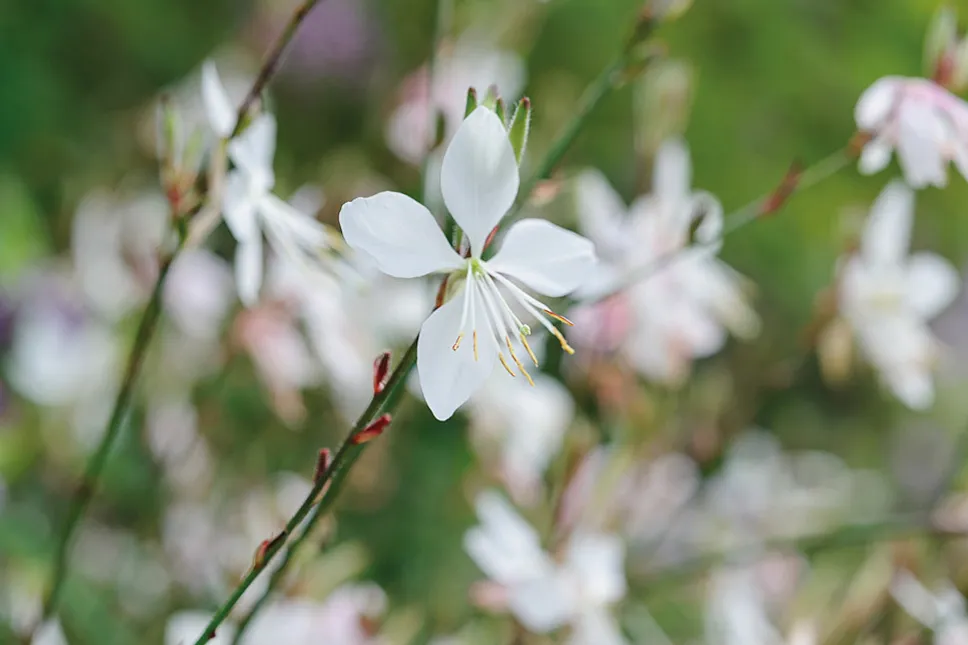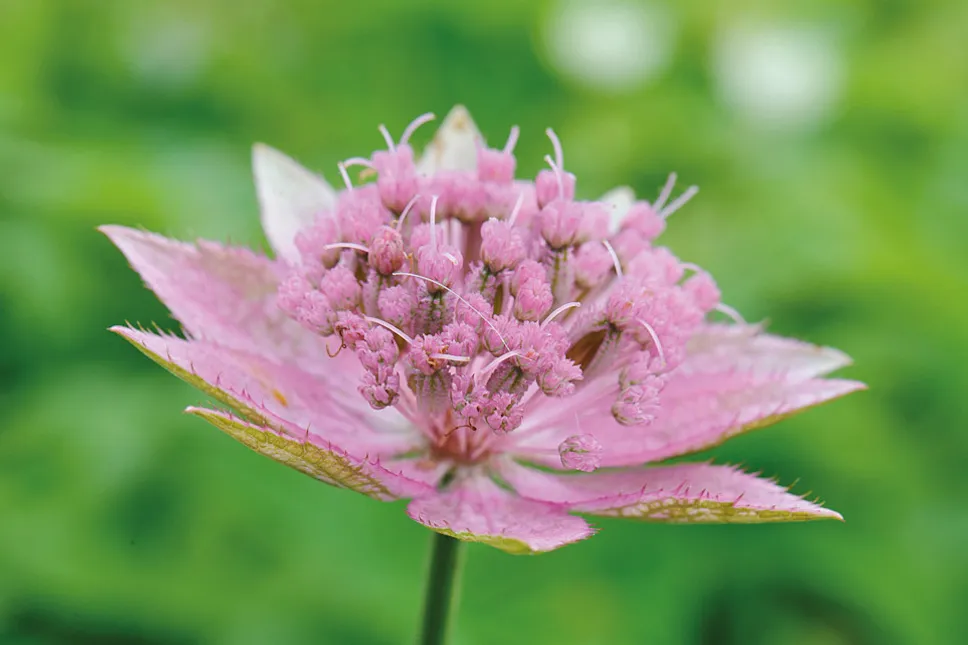The renowned plantswoman Beth Chatto learned the art of garden composition and plant combinations through years of practice in floral arranging. Inspired by the arrangements of Constance Spry and Julia Clements, Beth used materials from her garden to create floral displays rich in different textures and shapes. Soon she was lecturing throughout the country and selling plants to keen amateur arrangers. What set her apart then, and what is immediately noticeable in her garden to this day, is her focus on species plants. She was an early champion of Fritillaria imperialis and Cynara cardunculus, and never wavered in her love for the many greens of hellebores, euphorbias and her much-beloved Arum italicum ‘Marmoratum’. The only dahlia you’ll find in the garden is Dahlia merckii. So it was with much trepidation that I took on the responsibility of making her flower arrangements each week, while interning at the Beth Chatto Gardens and Nursery.
Traditional cut flowers require rich soil, irrigation and plenty of sun to repeatedly produce big blooms. The keen grower is expected to amend the soil before each planting, foliar and root feed weekly, and ensure plants are adequately supported by nets or staking throughout the growing season. At Beth’s I secured permission for a small, cut-flower border in an unused bit of stock bed, and diligently (or sometimes less diligently) did just that to grow my zinnias, cosmos, sweet peas and dahlias.

Yet, as the year went by, I relied less on my own cut flowers than on the interesting things I found in Beth’s garden. There was an undeniably enjoyable challenge in scouring the garden to catch flowers at their peak or find ways to incorporate the myriad foliage, including everything from geranium leaves to branches of Metasequoia glyptostroboides. It is a surprise, or perhaps an inevitable internalisation of that immortal phrase ‘right plant, right place’, to find myself now championing growing plants for cutting that can fend for themselves in a variety of conditions without irrigation and yearly additions of fertiliser. This shouldn’t be mistaken for low-maintenance, cut-flower growing, but it is low-impact growing, and perfect for those who share Beth’s deep love of plants and gardening.
We lost Beth in May 2018, at the age of 94, and it is a great credit to the staff of the Gardens and Nursery that she took pride and enjoyment in her garden into her final days. I have no doubt that the team will carry on her legacy of horticultural excellence, but also her love of flower arranging, in the years to come. Should you visit, you’ll still find jars in the prop shed holding a veritable to-do list of stems from garden plants ripe for cuttings or seed collection, and the tea room tables are graced with flowers from six acres of stock beds.
Flowers and plants from the Beth Chatto dry garden
1
Linaria purpurea ‘Canon Went’
From dry stony, environments, linarias like well-drained soil and tolerate drought. Well-branched plants send dozens of airy spires of tiny flowers. Other cultivars worth trying are the beautiful sea-shell pink ‘Pink Kisses’ or the sunset colours of ‘Peachy’. 90cm. RHS H6, USDA 5a-9b.
2
Symphoricarpos albus
An extremely undemanding shrub, with arching stems weighed down with berries in late summer and early autumn. Beth planted different species and cultivars. As an alternative try the blush-coloured S. x doorenbosii ‘Mother of Pearl’. 1.8m. USDA 3a-7b.
3
Cynara cardunculus
With silvery serrated foliage and spiked flowerheads, cardoons are great for arrangers who work on the large scale or want to make dramatic dried arrangements. 1.5m. AGM. RHS H5, USDA 7a-9b.
4
Gaura lindheimeri

As in the garden, the long, waving stems of gaura lighten an arrangement, picking up on the slightest breeze. Even in extremely dry conditions, they flower for months. 75cm. AGM. RHS H4.
5
Origanum ‘Rosenkuppel’
It’s a mystery why origanum is not more valued as a cut flower. It’s a wonderful filler, grows prolifically even in drought, flowers
for long periods, and is as ornamental in bud as it is in flower. I like ‘Rosenkuppel’ for its darker colouring. Another richly coloured cultivar with shorter stems is Origanum laevigatum ‘Herrenhausen’. 60cm. AGM. RHS H7, USDA 5a-8b.
6
Stipa gigantea

This grass provides a striking form in the garden and arrangements, catching the light and providing subtle flickering movement. I incorporated it into summer bouquets and Christmas decorations, all to good effect. 2.5m. AGM. RHS H4.
7
Phlox paniculata ‘Mount Fuji’
Richly scented Phlox paniculata is an exceedingly adaptable perennial in the border and an indispensable cut flower. Available in a multitude of colours the flowerheads are pretty on their own but also prolific enough to be unapologetically used as fillers in arrangements. 90cm. RHS H7, USDA 3a-8b.
8
Pulsatilla vulgaris
Beloved as much for its seedheads as for its early spring flowers, Pulsatilla is rich in texture. It begs to be stroked. There’s a range of jewel-tone colours available. 20cm. AGM. RHS H5, USDA 4a-8b.
9
Anemone pavonina
Like their larger cousins A. coronaria, these anemones make great cut flowers. If happily sited they will self-seed widely in a range of colours. You could easily mistake the petals for velvet. Beth’s original plants came from the artist Cedric Morris. 20cm.
10
Alstroemeria ligtu hybrids
Prized for their longevity in the vase, these multi-coloured flowers will be familiar to anyone who’s been to a flower shop recently. They are a more surprising addition to the dry garden, where they tolerate the freely draining soil by going dormant during the worst of the late summer heat. 50cm.
11
Galactites tomentosa
With distinctively variegated, thistle-like leaves and softly petalled flowers in white, pink and purple, this is a wonderful annual/biennial that mixes nicely in wildflower bouquets. 50cm.
12
Eschscholzia californica ‘Alba’

While the species flower is bright orange, Beth preferred this paler cultivar that now self-sows in abundance through the gravel garden. It’s excellent for cutting, as the buds will continue to open in the vase for at least a week. 40cm. USDA 6a-10b.
Flowers and plants from the damp garden
13
Pimpinella major ‘Rosea’

This enchanting umbellifer thrives in ordinary soil but prefers to be kept moist. With a sweet scent and a long vase life, It was my favourite discovery at Beth’s. 1.2m. RHS H7, USDA 5a-8b.
14
Caltha palustris
A common sight in damp, marshy areas. While their fleshy stems don’t lend themselves to much movement in the vase, they are long lasting. 60cm. RHS H7, USDA 3a-7b.
15
Trollius chinensis ‘Golden Queen’
Trollius are fantastic cuts for early summer and sturdy additions to borders with moisture-retentive soil. I particularly love the rich shades of yellow in this cultivar and also those of Trollius x cultorum ‘Feuertroll’. By deadheading, you can sometimes encourage a second flowering in autumn. 90cm.
16
Thalictrum finetii
Thalictrums, with their finely dissected foliage and delicate flowers, add textural interest to arrangements. At Beth’s we’re spoiled for choice, from heftily flowered Thalictrum finetii to the vibrant yellow flowers and glaucous foliage of Thalictrum sphaerostachyum. Most thalictrums thrive in moisture-retentive soil. 70cm-1m.
Looking for more on thalictrum?
17
Vernonia arkansana
With wide, bright-purple flowerheads, this is not a plant for the subtle arranger, but its seedheads colour beautifully, providing interesting texture before they’re blown away by the wind. While they prefer moist soils, vernonias also perform well in average garden conditions. 2m. USDA 5a-8b.
18
Tiarella wherryi
Tiarella easily pairs with hellebores in the garden and the vase, and has a sweet, if ephemeral, scent. But unlike the hellebore it will flower well into the summer. While it prefers a humus-rich woodland position, once established it will tolerate dry shade as well. 25cm. AGM. RHS H5.
19
Veronicastrum virginicum ‘Diane’
A North American native from moist meadows. Veronicastrums provide interesting uprights for the flower arranger in soft shades of white, cream and pink. 1.2m. USDA 3a-8b.
We explain how to care for an grow veronicastrum here
20
Podophyllum versipelle ‘Spotty Dotty’
A leaf from ‘Spotty Dotty’ is as striking a focal point in an arrangement as a dinner-plate dahlia. Performs best in shaded, moist, rich soils. 40cm. AGM. RHS H4, USDA 5a-8b.
21
Astrantia maxima ‘Rosea’

Astrantias are long lasting in the vase and if you don’t already grow Astrantia major, you should add it to the garden immediately. However, my new favourite is A. maxima for its large, dusty pink flowers and its late flowering time. This cultivar has an even richer pink. Prefers a moisture-retentive soil. 60cm. RHS H7.
22
Calamagrostis x acutiflora ‘Eldorado’
A variegated grass with subtly coloured immature flower plumes in greenish-mauve. Odd but wonderful. Tolerant of a variety of conditions if soil is well-drained. 1.8m.
23
Miscanthus sinensis ‘Rotsilber’
By late summer, plumes of miscanthus become an indispensable addition to arrangements. Some have interesting colours when the flowerheads are immature, and others provide good foliage. I used ‘Rotsilber’, ‘Ferne Osten’, and ‘Silberfeder’ most often. 1m. RHS H6.
24
Cyclamen hederifolium
No need to get down on your knees to admire the flared flowers and showy foliage of Cyclamen hederifolium if you put a few together in a bud vase or small dish with a spiked flower frog. Cyclamens happily naturalise through the border, but are especially beautiful in a grassy, bulb-studded woodland walk, as at Beth’s. 12cm. AGM. RHS H5, USDA 5a-9b.
Here's our profile on cyclamen
The Beth Chatto Gardens are in Elmstead in Essex and open every day of the year except between Christmas and new year.